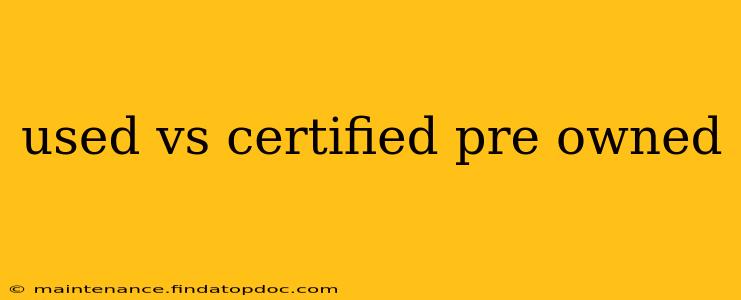Buying a used car can be a minefield of terminology and varying quality. Two terms often leave buyers confused: "used" and "certified pre-owned" (CPO). While both describe vehicles previously owned, the significant differences in warranties, inspections, and overall condition can dramatically impact your purchase decision. This guide will break down the key distinctions to help you make an informed choice.
What is a Used Car?
A "used car" is simply a vehicle that's been previously owned and driven by someone other than the current seller. There's no standardized inspection or warranty, meaning the condition can vary wildly. You're essentially buying "as is," relying on your own assessment (or that of a trusted mechanic) to determine its reliability and value. This offers potential for significant cost savings, but also increased risk.
What is a Certified Pre-Owned (CPO) Car?
A certified pre-owned (CPO) car is a used vehicle that has undergone a rigorous inspection and reconditioning process by the manufacturer or a participating dealership. This involves a multi-point inspection checklist, often including repairs to identified issues. Crucially, CPO vehicles typically come with an extended warranty, offering greater peace of mind compared to a standard used car.
What is the Difference Between Used and Certified Pre-Owned?
The core difference lies in inspection, reconditioning, and warranty. A used car offers no guarantees beyond what the seller may claim, while a CPO car undergoes a thorough evaluation and usually comes with an extended warranty covering potential repairs. This extended warranty significantly reduces the risk associated with buying a used vehicle.
How Thorough is the CPO Inspection Process?
The inspection process for a CPO vehicle varies slightly by manufacturer, but generally involves a comprehensive multi-point check of major systems including:
- Engine and transmission: Checking for wear and tear, leaks, and proper functionality.
- Brakes and steering: Assessing the condition of brake pads, rotors, and steering components.
- Electrical systems: Testing lights, electronics, and the overall electrical system.
- Suspension and tires: Examining for damage, wear, and proper alignment.
- Body and paint: Identifying any significant damage or imperfections.
After inspection, any necessary repairs are made before the vehicle receives its CPO certification.
What are the Benefits of Buying a Certified Pre-Owned Car?
- Extended Warranty: This is a major advantage, providing coverage for repairs beyond the original manufacturer's warranty.
- Rigorous Inspection: The comprehensive inspection ensures the car is in relatively good condition.
- Reconditioning: Any necessary repairs or replacements are typically made before sale.
- Enhanced Peace of Mind: The certification process reduces the risk of unexpected major repairs.
What are the Disadvantages of Buying a Certified Pre-Owned Car?
- Higher Price: CPO cars typically cost more than comparable used cars without certification.
- Limited Selection: The number of CPO vehicles available may be less than the overall used car inventory.
- Warranty Restrictions: The extended warranty usually has certain limitations and exclusions.
What are the Benefits of Buying a Used Car?
- Lower Price: Generally, used cars are significantly cheaper than CPO cars.
- Wider Selection: The inventory of used cars is usually much broader than CPO options.
What are the Disadvantages of Buying a Used Car?
- Higher Risk: You assume greater risk regarding potential repairs and mechanical issues.
- No Warranty (Usually): Most used cars are sold "as is," offering no warranty.
- Potential Hidden Problems: Hidden problems may not be immediately apparent.
Which is Right for Me: Used or Certified Pre-Owned?
The best choice depends on your budget, risk tolerance, and needs. If you're on a tight budget and are comfortable with the added risk, a used car might be suitable. However, if peace of mind and the added protection of an extended warranty are important, a CPO car is a better investment, despite the higher cost. Carefully weigh the pros and cons based on your individual circumstances.
